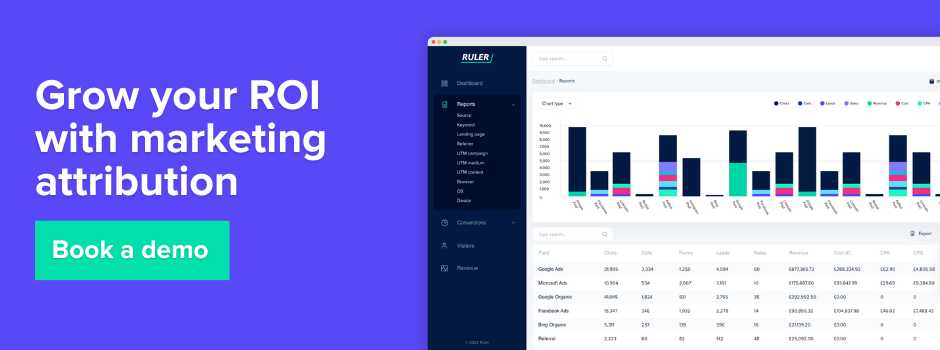We break down attribution models, highlight their blind spots, and offer practical ways to measure marketing more effectively.
Marketing attribution is the practice of assigning credit to the touchpoints that influence a customer’s decision to buy.
It helps marketers understand what’s working, what’s not, and where to invest. The stakes are high.
With budgets under pressure and every dollar expected to drive measurable return, attribution now shapes how large sums of ad spend are distributed across channels, campaigns, and tactics.
But for all its influence, many systems rely on flawed assumptions, incomplete data, or models that no longer match how people actually behave.
The result is a false sense of precision, and in many cases, costly misallocation of resources.
This guide goes beyond the basics. It will walk through the major attribution models, how they’re used, and where they fall short.
Also, it’ll cover what’s changing in the field and what marketers can do to build more accurate, reliable measurement.
We discuss:
💡 Pro Tip
This guide explains the fundamentals of marketing attribution and why it matters. If you’re interested in exploring platforms that can help you track customer journeys and connect outcomes to specific touchpoints, check out our dedicated list of top marketing attribution tools and software.
Marketing attribution is the process of assigning credit to the marketing touchpoints that influence a conversion.
It’s an attempt to answer a basic but critical question: Which activities helped drive this outcome?
Traditional attribution models approach this in different ways. Some give all the credit to the first interaction, others to the last.
More advanced models try to distribute credit across several touchpoints, based on rules or statistical methods.
These frameworks vary in complexity, but the goal shouldn’t be to claim credit for a win.
It should be to surface clear, usable insights about which channels, campaigns, and tactics are actually moving the needle.
Attribution isn’t just about reporting on what happened. It’s a tool for making decisions.
When done well, it helps marketing teams prioritise spend, refine strategy, and understand where value is being created across the full customer journey.
Most sophisticated attribution systems rely on deterministic tracking.
Related: Why you need both deterministic vs probabilistic models
This method connects touchpoints by using specific identifiers, cookies, user IDs, device IDs, email addresses, phone numbers, to recognise when the same person engages with different marketing activities.
The result is a joined-up view of the customer journey that links actions to outcomes.
Ruler is one example of this approach in action.
Its first-party tracking captures data like UTMs, click IDs, page views, and referrers across a user’s path.
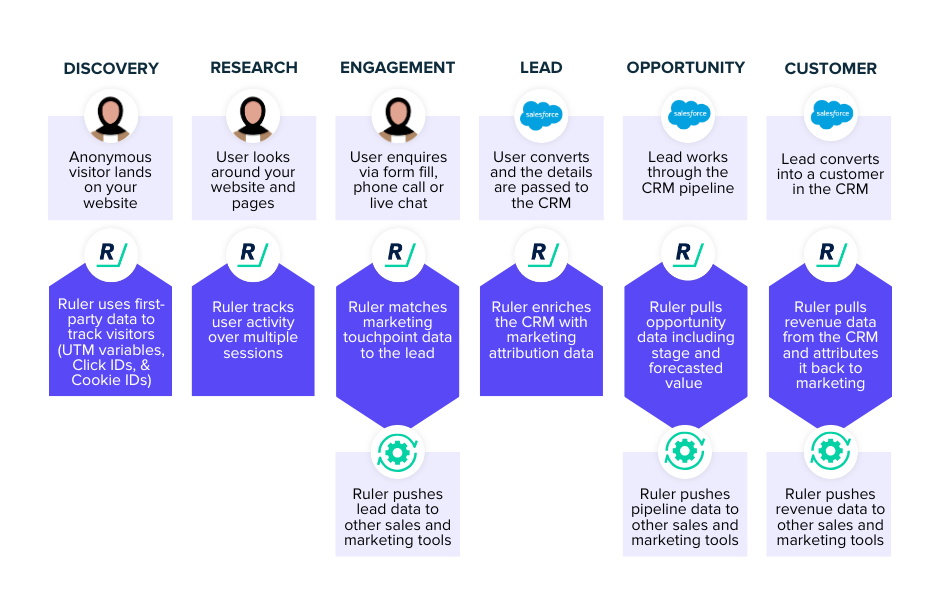
These signals are tied to conversions such as calls, chats, or form fills, and then matched to contact records in your CRM or ecommerce platform.
This makes it possible to trace offline events, like meetings or demos, back to the marketing source that first drove the lead.
Once a lead reaches a key stage in your pipeline, Ruler sends conversion data back to ad platforms using the same identifiers that started the journey.
This creates a feedback loop that connects performance data with spend, helping marketers refine targeting and improve bidding strategies.
Deterministic attribution has dominated for the past decade because of its precision.
When it works, it offers a clear line between marketing inputs and business outcomes.
Click paths, timestamps, and conversion sequences feel concrete, making this approach attractive to teams that want attribution data they can act on with confidence.
Attribution platforms use models to decide how to assign credit to marketing touchpoints.
These models follow rules that determine which interactions get recognised, and how much influence they’re given. There are two main types:
Single-touch models are simple and easy to implement, but they overlook much of the journey. In most cases, they miss the role of supporting touchpoints that help move a customer forward.
Multi-touch models spread credit across multiple interactions. These rule-based models aim to reflect the influence of different steps along the path to conversion.
While none are perfect, they can provide a more balanced view than single-touch approaches, especially in longer or more complex journeys.
Below are various attribution models, including common ones like first and last-click, as well as more advanced, multi-touch models.
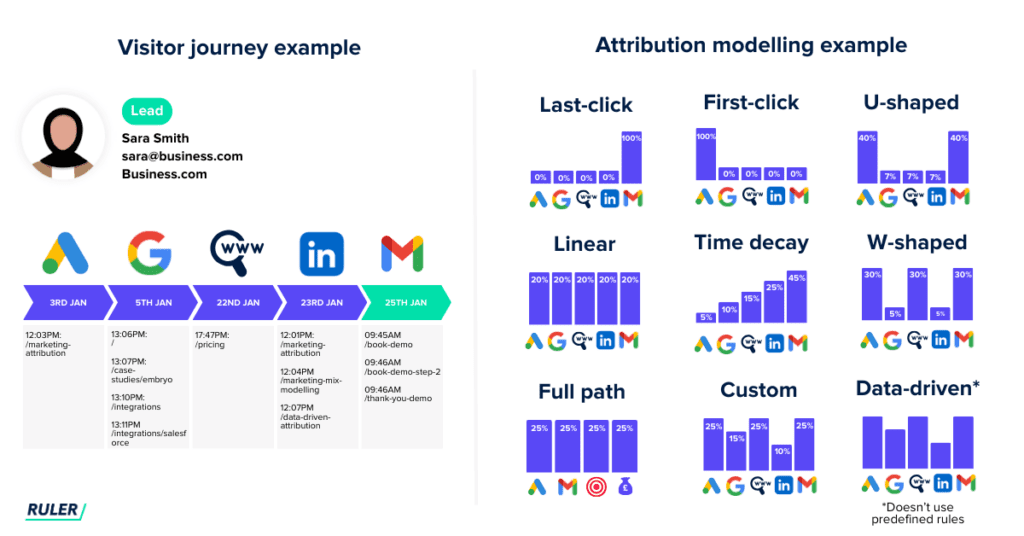
First-click attribution: Credit for a conversion is assigned to the very first touchpoint a user had that led them to your website. So, if a user sees a Google Ad for your company and clicks on it, all of the credit would be assigned to that PPC campaign, even if an email caused the user to convert.
Last-click attribution: Credit for a conversion is assigned to the final touchpoint experienced by the user before making a purchase. So, in the same example as before, all of the credit would go to the email that converted the user. But again, the Google Ad would be missed, along with the other steps that drove the user through their customer journey. As you can see, there are some issues with single-touch attribution.
Linear attribution: Distributes equal credit to all touchpoints in the customer journey, regardless of their position. Let’s use our example to help simplify it. A user clicks a Google Ad to explore your website but leaves shortly after. A few days later, they search for your brand on Google, browse around, and subscribe to your newsletter. They return to your site through a direct search to check pricing. Afterward, they visit your website again, prompted by a LinkedIn ad, ultimately converting through an email. Applying a linear attribution model, each touchpoint would receive equal credit of 20%.
U-shaped attribution: Also known as Position-based attribution, this model credits the first touchpoint and the one where the user becomes a qualified lead. In our example, both the Google Ad and email get 40% credit, while the rest is divided among other touchpoints.
W-shaped attribution model: Similar to the U-shaped model, the W-shaped attribution model allocates 30% credit to the first touchpoint, 30% to the touchpoint in the middle, and 30% to the final touchpoint. The remaining 10% is evenly distributed among other touchpoints. In our example, the Google Ad, direct search, and email each receive 30% credit. The organic search and LinkedIn ad share the remaining credit.
Time decay attribution model: Next, we have the time decay model. Time-decay assigns more weight to interactions that happen near the final conversion event. Using the same example as before, this model type will assign more credit to the email than it will to the Google Ad.
Full path attribution model: Credit is given to every touchpoint in the customer journey, starting from the first interaction to the final conversion. It emphasises the importance of the first and last touchpoints, as well as those during lead and opportunity creation stages.
The attribution models outlined above are rule-based.
They follow fixed instructions about how to distribute credit, regardless of whether those touchpoints actually influenced the outcome.
While these models provide structure, they often oversimplify how people interact with marketing.
Real customer journeys are rarely that neat.
Data-driven attribution (DDA) offers a different approach. It uses machine learning to analyse patterns in user behaviour and determine which touchpoints are most likely to have contributed to a conversion.
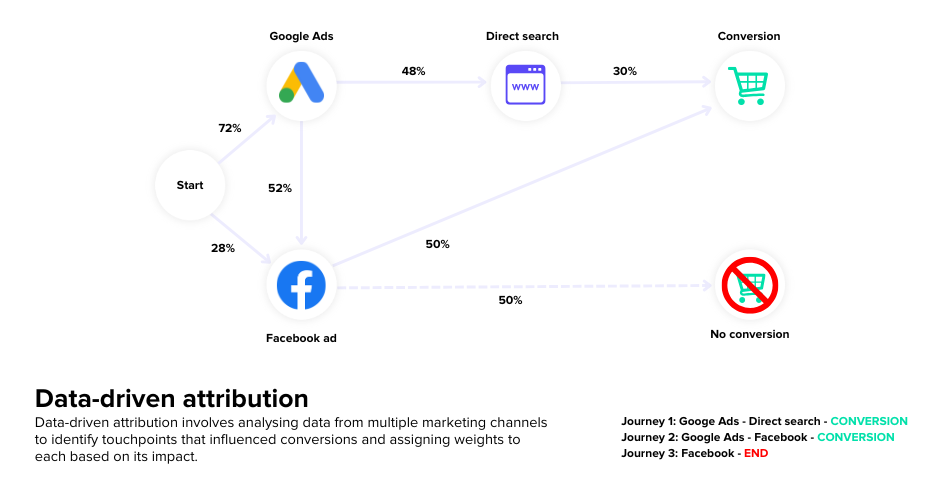
Instead of applying pre-set rules, DDA assigns credit based on observed impact.
This method removes many of the assumptions built into rule-based models. It adjusts to the data, rather than forcing the data to fit a model.
One of its strengths is the ability to surface the value of upper-funnel activity, touchpoints that may not be directly tied to conversions, but still play a role in influencing decisions.
You’ve likely encountered data-driven attribution in platforms like Google Ads and GA4.
These tools are investing heavily in DDA as a default model.
But while the output may be more accurate, the process behind it isn’t always transparent.
Marketers often don’t know how credit is assigned or what data is being used. That lack of visibility can make it difficult to interpret results, or trust them.
Deterministic attribution plays a key role in both measurement and activation.
By tracking identifiable interactions, like clicks, form fills, or phone calls, marketers can map customer journeys, tie them to CRM records, and push conversion data back into ad platforms.
This creates a feedback loop that helps optimise campaigns based on clear, trackable outcomes.
But deterministic attribution has a limitation: it only works when there’s a traceable action.
In most cases, that means a click. If someone sees an ad but doesn’t engage with it directly, the system has no signal to track.
Take this example: a person sees your display ad but doesn’t click. A few days later, they search for your brand on Google and convert.
Almost every attribution model will credit the Google search or the direct visit, not the display ad that introduced them to your brand.
This isn’t a rare exception. Studies suggest that for every ad click, there are 10 to 50 impressions that don’t result in a click but still shape decisions.
These unseen influences – especially from upper-funnel campaigns like display, video, and brand awareness – are routinely ignored.
The result is a systematic bias. Attribution models overvalue direct response and undervalue demand creation.
That leads to underinvestment in the very activities that build awareness, trust, and future conversions.
Many marketers rely on the attribution data provided by the platforms they advertise on.
It’s accessible, built-in, and often looks detailed.
But it comes with a critical flaw. Each platform only tracks what happens within its own ecosystem.
Facebook Attribution reports on Facebook touchpoints. Google Attribution reports on Google touchpoints.
Neither sees, or credits, what happens outside their walls.
This creates what’s known as platform attribution myopia. Each platform acts as a walled garden, blind to the influence of others.
The result is a fragmented measurement system where every channel claims more credit than it deserves.
If you add up all the conversions reported by individual platforms, you’ll often end up with a number that far exceeds your actual results.
This happens because conversions get counted multiple times.
A single sale might be claimed by Facebook, Google, and your email platform, all unaware of the others’ involvement.
If Facebook shows 250 conversions and Google shows 280, it’s tempting to believe you’ve driven 530 conversions.

But your CRM or sales data might show just 300. The rest is duplication.
This inflated reporting leads to false confidence. Channels that appear to be top performers get more budget, even if they’re contributing less than it seems.
And because platforms are paid based on performance, they have strong incentives to over-attribute their role in the journey.
To solve this, many marketers turn to Google Analytics 4.
It promises a more complete view. But GA4 comes with its own set of limitations. It offers only two attribution models, last click and data-driven, and the latter is a black box.
Related: 8 limitations of Google Analytics 4
You can’t inspect the logic or understand how credit is assigned.
The attribution window maxes out at 90 days, which is often too short for B2B sales cycles or high-consideration ecommerce purchases.
And like other deterministic tools, GA4 doesn’t account for impression-based interactions or track key offline events.
In trying to reconcile conflicting platform data, marketers often find themselves with yet another incomplete picture, just one that feels more neutral.
But the core challenges remain: partial visibility, duplicated credit, and unreliable signals that distort budget decisions.
Deterministic attribution still plays an important role in marketing measurement.
As discussed earlier, it allows teams to track specific interactions, connect touchpoints to conversions, and feed structured data back into platforms for optimisation.
Marketing attribution software like Ruler show the value of this approach by capturing detailed user journeys, clicks, UTMs, page views, and conversions, and linking them to CRM records and offline outcomes.
But relying solely on attribution from ad platforms or even from tools like Google Analytics creates blind spots.
Platform data is fragmented and self-interested. GA4 is limited in scope and lacks transparency.
Even first-party tracking, while a major step forward, can’t fully account for untracked impressions, offline interactions, or the broader causal impact of marketing.
The picture it paints is clearer, but not complete.
That’s why a unified measurement approach is needed. The next step is triangulation.
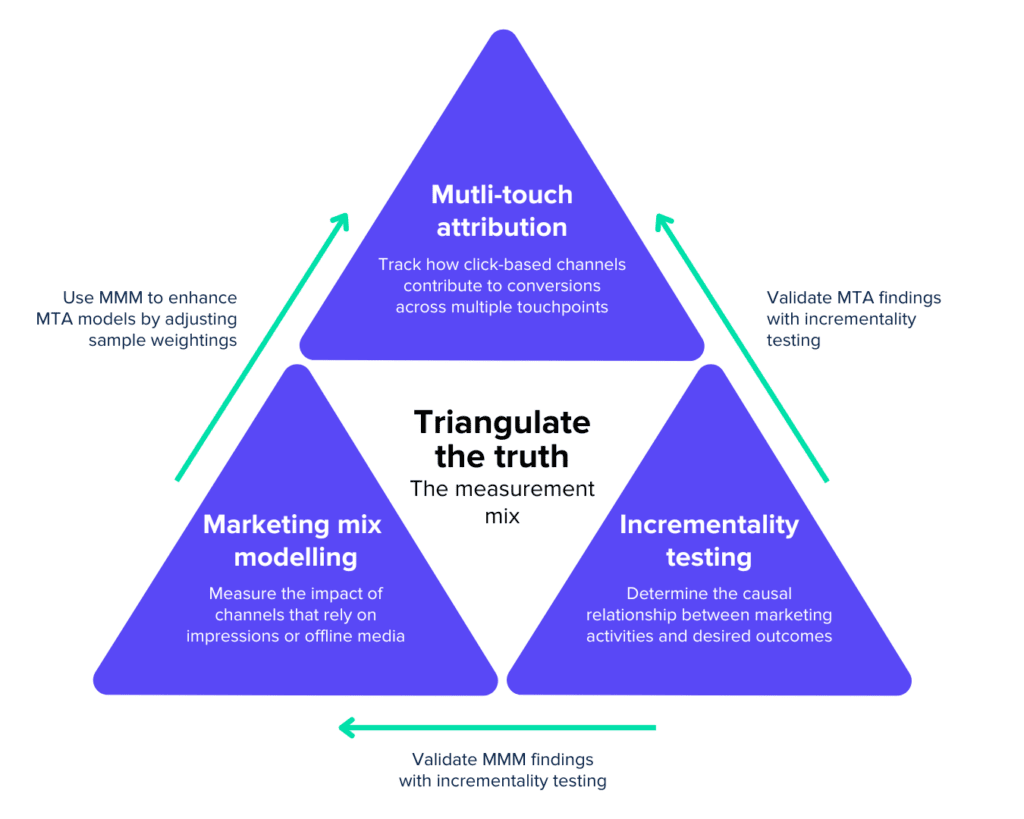
Measurement triangulation involves combining multiple methods to cross-validate results and reveal a more accurate understanding of marketing effectiveness.
Marketing attribution gives one view, but it must be balanced with methods that can account for the limitations of observational tracking.
One of the most powerful tools in this mix is incrementality testing.
Unlike attribution, which infers influence from observed user behaviour, incrementality uses experimental design to measure the true causal impact of marketing.
The simplest form is a geographic holdout: pause campaigns in some regions, continue in others, and compare outcomes.
If conversions drop by 15% in the holdout markets, that’s a 15% lift directly driven by your marketing, regardless of what attribution data says.
Audience-based testing works the same way.
You split similar audiences into test and control groups, serve ads to one and not the other, and observe the difference in performance.
These methods often surface results that challenge assumptions. High-performing search campaigns may prove to be mostly harvesting existing demand.
Meanwhile, display campaigns that seem ineffective in attribution reports may actually drive substantial incremental lift.
The third pillar in a triangulated measurement framework is marketing mix modelling (MMM).
This approach looks at marketing performance at the aggregate level.
Rather than tracking individual users, MMM uses statistical models to analyse how changes in media spend, impressions, and other inputs affect business outcomes over time.
It also accounts for external factors – seasonality, macroeconomic shifts, competitor activity – that attribution systems typically ignore.
Modern MMM can show not just which channels are contributing to growth, but how they interact, how results are influenced by market conditions, and how confident you should be in the estimates.
Instead of precise but misleading percentages, MMM offers confidence intervals and significance testing.
That statistical discipline makes it easier to make informed, resilient budget decisions.
Attribution is one lens. But to see clearly, marketers need all three.
💡 Pro Tip
When you combine attribution with methods like incrementality testing and marketing mix modeling, you get a fuller picture and more reliable data to prove what’s working and make confident budget decisions. We’ve outlined the steps to get started in our marketing measurement framework.
When building a unified approach to measurement, attribution, incrementality, and MMM are the core pillars.
Together, they provide a balanced view:
At Ruler, we’ve added a layer that connects these methods directly within the attribution workflow.
Our Data-Driven Attribution + Impression Model integrates insights from MMM to address one of the biggest gaps in deterministic systems: the undervaluation of upper-funnel activity.
The model works by applying MMM-derived weightings to data-driven attribution results.
These weightings are designed to reflect the true influence of channels like display and social media, campaigns that build brand awareness but rarely get credit in traditional attribution.
By re-weighting attribution outputs, the model shifts some credit away from lower-funnel touchpoints like brand search or direct traffic, and assigns it to the upper-funnel activities that made those conversions possible in the first place.
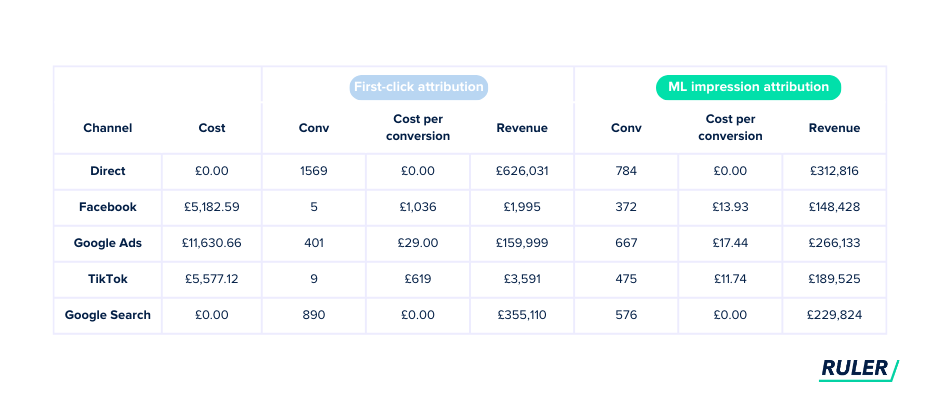
This hybrid model combines the precision of deterministic tracking with the contextual insight of MMM.
It allows marketers to maintain the traceability of click-based journeys while correcting for the blind spots that attribution alone can’t fix.
For teams that don’t yet have their own MMM models, we offer industry-specific weightings based on campaign type, vertical, and marketing maturity.
These provide a practical starting point for more balanced attribution in the absence of custom econometric analysis.
Crucially, this modelling approach also reinforces findings from incrementality testing.
If a test reveals that display campaigns are driving lift, our impression model should show similar shifts in attribution credit.
In that way, these tools work together – triangulating impact, validating each other’s insights, and helping marketers build a measurement framework that reflects how marketing actually works.
Marketing attribution has become a foundational tool for understanding how marketing drives outcomes.
But as we’ve seen, relying solely on platform data or simple rule-based models can lead to blind spots, duplicated credit, and distorted budget decisions.
Deterministic attribution has its place, especially when powered by first-party data, but it must be viewed as part of a broader measurement strategy.
By combining attribution with incrementality testing and marketing mix modelling, marketers can move from narrow reporting to a more complete understanding of what truly drives performance.
At Ruler, we’ve built a product that not only connects deterministic data to your CRM but also integrates impression modelling and MMM-informed weightings, giving credit where it’s due across the full customer journey.
If you’re looking to build a measurement framework that reflects how your marketing really works, not just how it’s tracked, we’d love to show you how Ruler can help.
Book a demo today and see how a more accurate, unified approach to attribution can transform how you measure, allocate, and grow.
